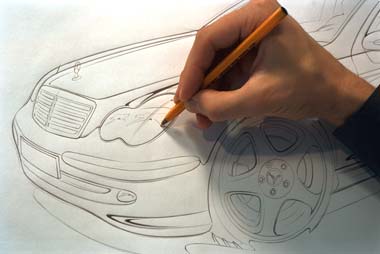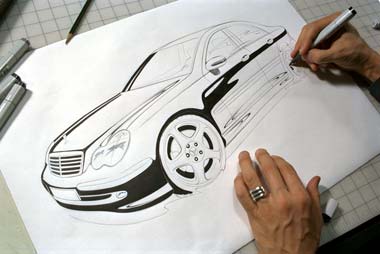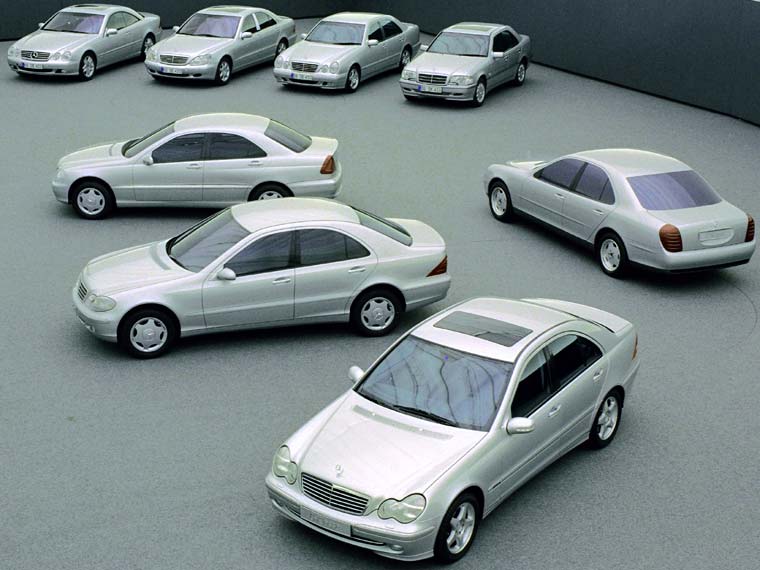c

| 24 graphics and photos below
optimized for 800x600 screen resolution |
499KB |
A design sketch photographed from a computer's workstation
monitor.
All graphics and photos by DaimlerChrysler,
further preparation for the web by MBEP
webmaster.
All texts in "this is text" by
DC, all other text by MBEP webmaster.
DC design team members please note
that some of the graphics and photos are isolated from other graphics and
photos and that some designers autographs were changed in colour and/or
size and/or location to fit into the specially prepared graphics for this
web page.
MB's new mid-size sedan C-Class W203 already is on the
market since two months - so it's high time to show the design studies,
isn't it ? ;-)
The sketches and especially the models show how the new
series could have looked like. The very first design work began at least
at in June 1994 - that's nearly exactly six years before production started.
Besides the resulting design studies it's particularly
interesting that different tools and media are being used in the design
process: Paper and pens, on-screen computer graphics, virtual-reality equipment
and scale models.
DaimlerChrysler defined its design target as follows:
"Character formation - this was the designers’ brief.
They were tasked with giving the new Mercedes-Benz C-Class a dynamic character
which both instills affection and from the very first glance leaves no
doubt about its pedigree. In short, the resulting sedan had to visually
reflect Mercedes-Benz’s new, progressive brand image.
But, in addition to sporty dynamics and youthful attractiveness,
the remit also specified embodying the typical elegance of a Mercedes sedan.
The design of the new C-Class is a study in integration.
It unites different worlds and spontaneously grabs the attention of people
with completely different aspirations and interests. Three design and equipment
lines - Classic, Elegance and Avantgarde - simplify the realization of
individual wishes in terms of form, colors and materials."
Can the new C-Class meet this definition? You can find
my personal opinion at the end of this page.
MBEP
webmaster July 2000
 |
 |
It all begins with a sheet of paper
and a pen.
The colourization dramatically adds to the 'reality' of the
sketches.
Two designs being radically different from all the rest -
futuristic and conventional at the same time.
Much more "tame" designs, but already clearly showing variations
of the "Updated interpretation of twin-headlamp face" as DaimlerChrysler
calls it. Following is the full DC explanation:
"The headlamps are again character-shaping features.
While the famous twin-headlamp face of the E-Class in 1995 was the visible
signal of a new departure for the Mercedes-Benz brand, the C-Class re-interprets
this symbolism, thereby marking the launch of the next stage in Mercedes-Benz’s
product offensive.
Although the sedan's four ”eyes” are still identifiable
, the design of the new C-Class has seen the oval headlamps merge into
harmonious units in line with the basic brief of integration. The hood
and fenders pick up this rounded finish and continue it backwards in sweeping
curves, forming elegant sheet-steel sculptures. Associations with the human
anatomy are inescapable, as the shape of the fenders is reminiscent of
the muscles of trained athletes.
Seen through the eyes of the designers, these athletic
forms enhance the width of the car's body, giving a powerful appearance
particularly when viewed from the front. This effect is reinforced by the
bumper which is perfectly integrated in the bodywork with the discreetly
molded spoiler edges in the lower section and the front fog lamps, especially
as all the components use the same paintwork - in body color - and therefore
present a unified whole in color terms too.
The interplay of dynamics and elegance is also seen in
the radiator grille and headlamps. The designers have skillfully worked
with different rake angles here to draw attention to the new C-Class’s
two features: while the slightly raked headlamps are reminiscent of a sports
car, the fins and webs of the radiator grille are decidedly more upright.
The effect of optically stretching the hood in this way is to give the
car power and elegance. This is particularly noticeable in the Elegance
and Avantgarde lines where the radiator grille has a high-gloss paint finish
and is trimmed with chrome strips."
Of course DC has as much to say about the rear as they had
about the front:
"Compact proportions at the tail The tail has been deliberately
designed to contrast with the hood of the new Mercedes sedan - at least
as far as proportions are concerned. The designers have done this to reinforce
the wedge-shaped outline of the body while guiding the eye unfailingly
to the car's beating heart.
At the same time, they have ensured a dynamic, compact
appearance by means of the short tail. Because, although the new C-Class
at around 4.53 meters is ten centimeters longer than the outgoing model,
it still remains an agile and maneuverable car with good visibility. And
”short” with regard to the tail design is not to be equated in any way
with ”small” because the trunk lid opens to reveal a family-sized luggage
space with a capacity of up to 455 liters (measured in accordance with
the VDA method).
Like the headlamps, the rear lamps are now also regarded
as typical stylistic elements of new Mercedes models with a sporty yet
elegant character. The tail lamp covers extend in a wedge shape into the
flanks of the body, underlining the car's sporty lines. This overlapping
lamp design was first used on a standard-production car in the SLK roadster
and then also caught the eye in the S-Class and the top of the range CL
coupé - not just because of its striking shape but also as an integrating
style element for formally linking the side and tail sections.
You want more? No problem, DC continues:
Body and fenders create a unified whole in terms of both
form and color Further similarities with other Mercedes models are seen
in the V-shaped cut-out in the tail of the new C-Class, which is also formed
by the tail lamps. They ensure the formal integration of the entire rear
end – creating the visual links between the fenders, trunk lid and bumper.
At the same time, the trapezoidal tail lamp design and the large-format
bumper emphasize the width of the sedan, which therefore also makes a particularly
powerful impression
from the rear. The bumper merges almost seamlessly into
the body and also forms a unified entity in color terms with the elegant
metal skirt.
The area in the V-shaped cut-out between the tail lamps
is reserved exclusively for the trunk lid which swivels very high to facilitate
access to the load compartment. The spoiler edge on the trunk lid is discreet
but aerodynamically very effective as it reduces the lift on the rear axle
and therefore increases handling safety."
Ok, that should now really be enough from DC about the
rear, shouldn't it?
"Process: computer design
The Mercedes designers made consistent use of new, forward-looking
technologies for the first time in the design process for the new C-Class.
Although drawing pads and crayons are still very popular tools for sketching
new shapes, designers are reaching ever more frequently for their mouse
and electronic graphics tablet. Computers are revolutionizing the car design
process. They enable many variants of a model to be tested, to be changed
with minimum input and the results to be compared very quickly with the
specifications of the design brief. And all this without having built a
model, bent a sheet of metal or molded a dashboard. In other words, computers
multiply the creative opportunities while saving time and money.
Even the first, draft computer designs of the new C-Class,
which were still two-dimensional, very quickly revealed whether the stylistic
proposals were compatible with the dimensional concept which had been specified
at an early stage. This basic data is stored in the computer's electronic
memory as what is called a proportional model and serves as a reliable
reference for the designers at every design stage to enable them to match
their visions to reality. Are the angles of rake of the windshield and
A-pillar correct? Is the hood high enough to accommodate all the engine
versions? The computer answers such questions at the click of a mouse.
Journey to the third dimension
However, the effect of the various draft designs which
appeared on the computer screen in accordance with these specifications
could only really be assessed once the third dimension was added. The designers
created this spatial effect by defining the surfaces of their draft designs
using programs specially developed for automotive design. The computer
had to perform complex calculations until it finally set a fascinating
process in train: hundreds of surfaces formed on the monitor within seconds
to create a complete sedan which could now be rotated at will on the screen
and viewed from any angle. The computer data for the draft design at this
stage occupied some 20 Megabytes - though this figure was later exceeded
many times over once even more details had been incorporated.
The ”Power Wall” took the process one stage further.
This operates on the same principle, but projects a life-size 1:1 scale
image with a realistic impression of depth and in even greater detail."
 |
 |
On the left-hand side is an interesting sketch, showing similarities
to the 'Coca-Cola' bottle car design style of the early 1970`s, with an
upward curve above the rear wheel.
The right-hand side sketch is very close to the final
car, only things like the wheels and the door sills are a bit different
- for the final car see the photo row directly below.
For comparison here are a 1:4 scale clay model and a photo
of the final car side-by-side.
DaimlerChrysler themselves say about the design of the
car's flanks:
"Pronounced wedge-shaped body and powerful shoulders
Seen from the side too, the dynamic character of the
new C-Class is the dominant first impression. This is ensured primarily
by the pronounced wedge-shaped body which is particularly defined by the
curve along the waistline. The conscious emphasis on what is generally
known as the waistline actually calls to mind the broad shoulders of a
well-built athlete, topped by the side windows, roof pillars and roof.
This line runs continuously from the front to the rear end, giving form
to the power of the body - particularly at the rear where the striking
C-pillars meet it and jointly define the form of the rear end."
Clay models with applied paint folios showing the flow of
light - giving a much more realistic impression than the pure clay model
can.
The left-hand sketch showing a very prominent position of
the central display, weak point of the positioning of the "Comand" systems
in all actual production MB's is that they are positioned too low.
The sketch on the left clearly shows conventional round instruments,
unlike with the final car, which can be seen on the projection in the 'cave'
on the right hand side.
"The ”Cave” is the name given by the stylists to the
room where a computer generates draft design images which are so realistic
and three-dimensional that you feel you could get straight into the car.
It is an acronym for ”Computer Aided Virtual Environment” and opens the
door to another reality for car designers: virtual reality (VR). Four powerful
projectors, termed ”beamers” by the experts, generate the virtual car.
Each projects a specially calculated image onto one of the four projection
surfaces in the ”Cave”: the floor, the rear wall and the two side walls.
Each measures three meters by three meters, which adds up to a total projection
area of 36 square meters. The projection initially seems two-dimensional
to the viewer, but putting on 3D glasses creates the fascinating spatial
image."
 |
So at the end with the photo above
in mind which shows some more W203 1:1 scale models aside other MB models
the question to be answered is: Did DC succeed in reaching its design target
defined as "a dynamic character" and the "visual reflection of Mercedes-Benz’s
new, progressive brand image" ?
Yes - on the one hand: The car
is dynamic and it shows many similarities to the second-newest MB sedan,
the bigger S-Class which definitely embodies MB`s new brand image.
But the answer also is "no", because
on the other hand the design is very traditional, not featuring any leading
new details: A chance has been missed to get ahead of the competition in
terms of design.
All graphics and photos above by
DaimlerChrysler, further preparation for the web by MBEP
webmaster.
All texts in "this is text" by
DC, all other text by MBEP webmaster.
Those who are interested in design studies
of the current S- or E-Class please click below:
©2000 by
MBEP
webmaster This is a private, non-commercial home page. For detailed disclaimer
click here
This is a private, non-commercial home page. For detailed disclaimer
click here

























